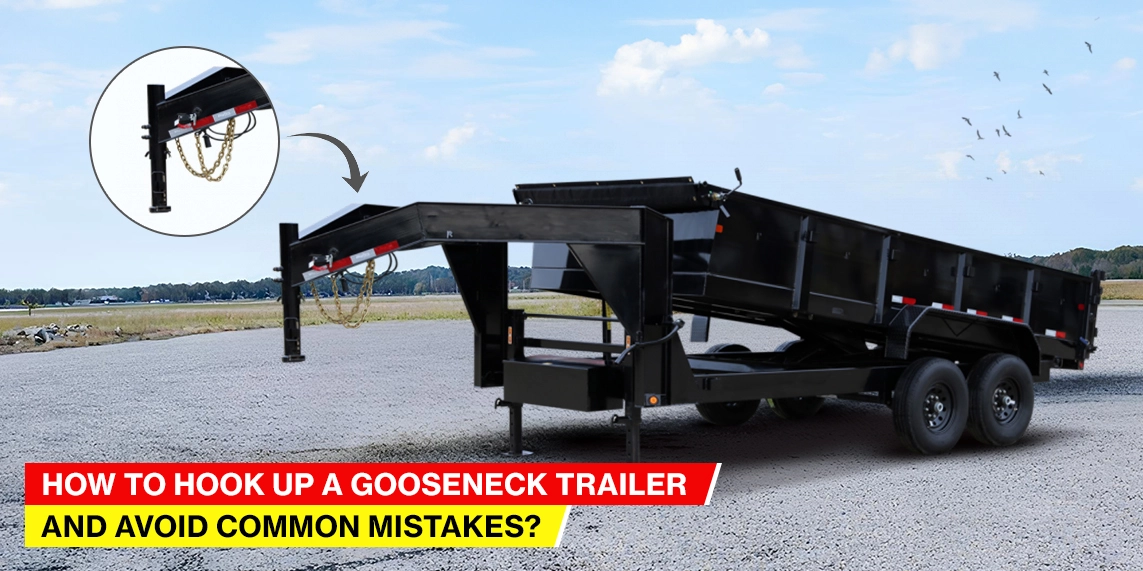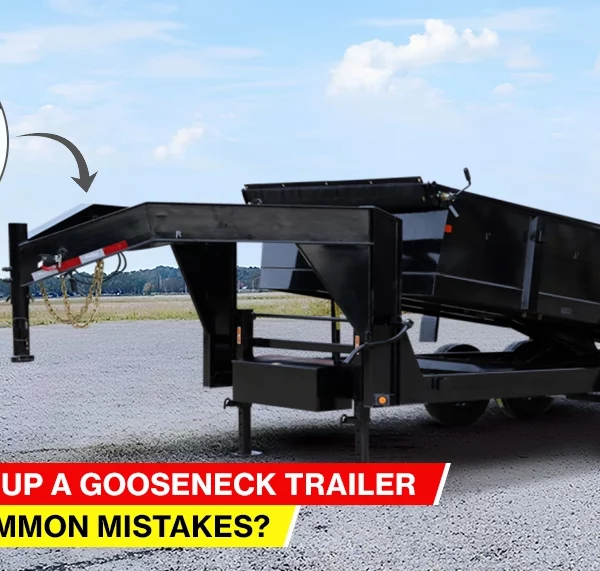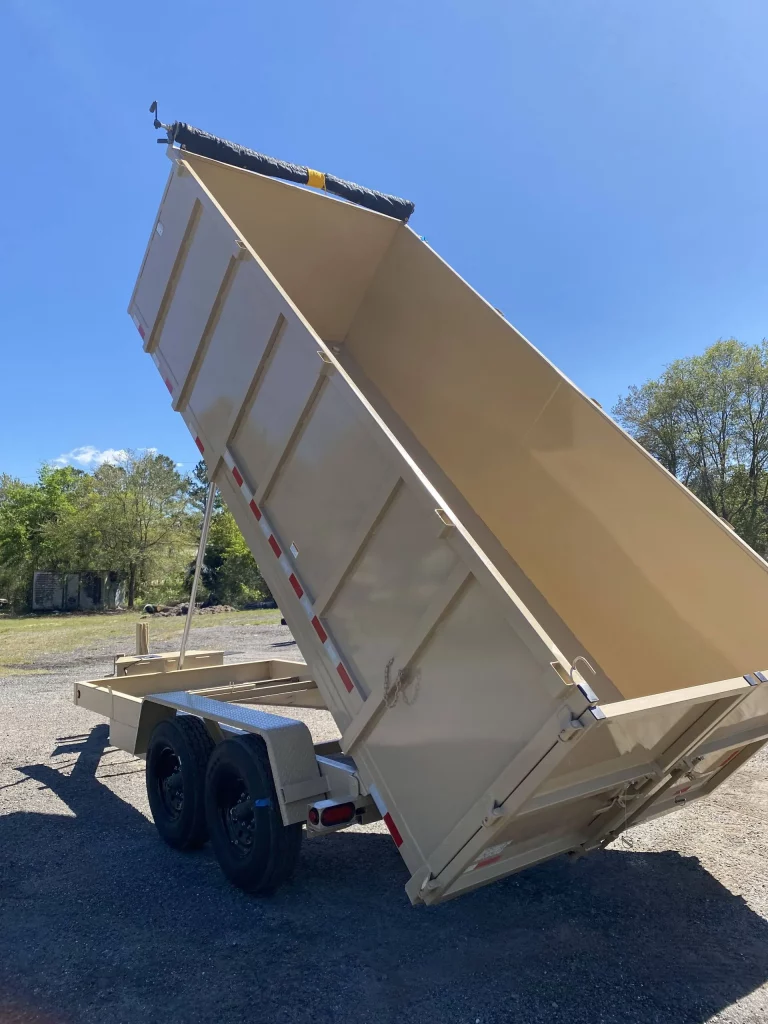Trailers primarily ship heavy-weight objects, such as bulky equipment, livestock, and recreational vehicles. To identify the perfect option, you must ideally understand your intentions with the trailer.
It’s necessary to mention that trailers are available in two types: gooseneck and bumper pull. You must pick gooseneck trailers if your work involves you engaging in significant towing. It would benefit you to be thoroughly versed in correctly hitting a trailer to a vehicle. Indeed, you don’t need your load or your car on the road if your trailer goes rogue after disconnecting in the middle of the journey.
Learning how to connect a gooseneck trailer properly will save you from facing an accident. You will be effectively risking other people’s lives on the road if you fail to secure your trailers to your vehicles.
If you secure the trailer on the truck’s ball, the trailer may lose the lock and get rid of the truck’s ball. Alternatively, you can secure the trailer on the ball and clip the safety chains to ensure a double hookup to the vehicle. Therefore, you must always guarantee proper hookup for your gooseneck trailer before getting behind the wheel and hitting the road.
If you are new to gooseneck hitches, we have the perfect blog for you. Continue reading to learn how to hook up a gooseneck trailer.
What is Gooseneck Hitch?
A gooseneck hitch can best be defined as a Class V hitch fixed into the pickup truck bed, offering a trailer ball for the gooseneck trailer connection. The name “gooseneck” comes from the hitch’s resemblance to a goose’s neck. Although the name sounds cute, the hitch is opposite to the gooseneck connection.
Gooseneck hitches promise optimum towing muscle and stability. They allow you to carry roughly 30,000 pounds of livestock, agricultural products, and heavy-duty equipment. When it comes to the primary components, a gooseneck hitch features the ball hitch and the plate (if applicable).
The ball hitch is attached to the truck bed surface, effectively meeting the gooseneck hitch coupler on a trailer. Additionally, in some systems, a plate on the truck bed facilitates the upward protrusion of the hitch ball.
A gooseneck trailer hitch lock is widely appreciated for the extra layer of security positioned on or around the coupler. Furthermore, you will find anchors in most systems that connect the safety chains. In simple terms, gooseneck hitches facilitate truck-trailer arrangements to move and maneuver more safely than other available options.
Types of Gooseneck Hitches
The hitching system you can find in gooseneck trailers provides stability, optimum strength, and ease of use. If you are planning to get a gooseneck trailer, your first step will be exploring the available options.
You will find three basic gooseneck options to choose from:
Gooseneck Puck System Kit
In modern times, most trucks and trailers include truck bed puck systems in their engineering designs. Gooseneck hitches have attachment points to facilitate trailer towing. To avail of a gooseneck puck system kit, you will need puck systems in your trucks. Puck systems come in a variety of brands, allowing you to find a pick that matches the system.
Traditional Gooseneck Hitch
However, if your trucks don’t feature factory-equipped puck systems, then your next best bet is a traditional gooseneck hitch. Their kits feature hardware and brackets to facilitate bolting onto beds and truck frames. We recommend drilling and modifying trucks with safety chain U-bolts to fit the system.
5th Wheel Gooseneck Hitch
Thirdly, there’s the 5th wheel gooseneck hitch that can be used to tow bigger and heavier loads. The truck bed spacing is the most apparent difference between a standard gooseneck hitch and a 5th-wheel variant.
As per the design, the 5th wheel gooseneck will take up a more considerable pace than standard hitches, with superior carrying capacity. You can get compatible gooseneck hitches from the market if your truck features permanent 5th wheelbase rails. Therefore, your trucks will now have a gooseneck adapter or 5th wheel.
Pre-Hookup Preparation
Gooseneck trailers promise a tighter turning radius, which complements navigation in tight spaces. However, you should devote complete attention to this hitching mechanism during the gooseneck trailer hookup. Doing so will ensure everything is good and functioning as expected.
We recommend that you run extensive pre-towing safety checks before beginning any towing adventure. These checks can help you sidestep any potential accident, thereby promising a safe towing experience.
- You should begin by evaluating the towing vehicle. Make sure the vehicle’s towing capacity is sufficient to support the weight of the trailer and its load.
- Assess the hitch and ball mount for any signs of wear and tear. Additionally, confirm if the gooseneck ball is tightly fixed to the truck bed. Next, we must transition to the trailer.
- Figure out the tire conditions to ensure proper inflation and no signs of damage.
- Also, check the braking and suspension system of the trailers to identify any issues.
- Confirm that all lights, including signal and brake lights, function at their best.
How to Hook Up a Gooseneck Trailer?
If your vehicle already has the necessary modifications, we can break down the process of hooking up your gooseneck trailer into eight steps. You must note that a variety of gooseneck trailers are available on the market today. However, the process of hooking up each is identical to some extent.
We have explained these steps to help you learn how to hook up a gooseneck trailer:
Raising Trailer Height
You need to consider improving your trailer height to hook up your gooseneck trailer. We recommend keeping the height of your trailer higher than that of your truck bed using the jack. This will allow you to gain adequate space to move as you are backing in.
Aligning the Coupler and Lowering the Trailer
You will need to gently turn your truck until it is based right below the trailer coupler. We recommend this to keep the hitch ball directly beneath the coupler. Moreover, you must park the truck directly adjacent to the trailer.
You must refrain from connecting a trailer to a ball at any angle. It will make your intention to connect the trailer to the vehicle more challenging. This is when you may find the spotter to be of notable assistance, effectively indicating that everything is aligned correctly.
With the help of a jack, lower the trailer gradually onto the ball mounted to the vehicle. Once the coupler snaps into place, flick the pin on the latching mechanism down to the locked position, allowing the coupler to latch into the locked position.
Raising the Jack Feet and Securing the Jack Handle
Now that the trailer’s weight has shifted to the vehicle bed, you should find it convenient to lift the jack feet. Keep a pin above each foot, which will free them if and when pulled. Lastly, secure the jack handle.
Connecting the Breakaway Cable
You must now concentrate on securing the huge safety chains on the truck using clamps or hooks. You will find the safety chains fixed to the trailer’s frame. You may discover emergency braking mechanisms in the majority of big gooseneck trailers. They typically contain a short rope that is hooked to a pin.
Attaching the Safety Chains
It’s time to grab the safety chains and fix them to the u- or d-bolts in the truck’s bed as soon as you attach the breakaway line. We recommend you attach chains on each side of the hitch system.
Plug a pin out if the truck and the trailer lose connection, which will effectively suspend the trailer’s braking system. Such circumstances will only occur if the trailer pivots from the vehicle. The additional safety feature will come into play if your trailer is independent of the car pulling it.
Closing the Coupler
You must implement the last step in hooking up the trailer to the truck before you consider attaching any electronics. Next, you should identify the coupler and the safety pin to see if both are in the closed position. Closing the coupler guarantees a reliable connection.
Plugging into the Outlet
Gooseneck trailers have a plug that reaches your vehicle’s braking and signaling system. Make sure you have plugged this into the correct Outlet. If you are struggling to identify the connection on the truck bedside, we recommend you explore the rear bumper instead.
It’s necessary to mention that several vehicle engineers and designers include an out on the truck-bed side. Once you have connected the plug, you may turn off the tailgate.
Carrying Out a Safety Inspection
Executing the safety check is the eighth and concluding step of this process. Get yourself on the trailer’s rear bumper end, and have an associate take the wheel to operate the brakes, marker lights, and turn signals. You should move your trailer gently to find out if the electronics are operational. This will reveal if there is a stable connection.
Common Mistakes When Hooking Up Gooseneck Trailers
How to hook up a gooseneck trailer may seem like a walk in the park. However, you must put effort into avoiding some common mistakes. This will help you prevent damage to your vehicle or safety hazards.
Here’s a deep breakdown of pitfalls you must avoid when hooking up gooseneck trailers.
Picking the Wrong Hitch
Keep off picking improper size or type of hitch for your truck and towing needs. There’s no denying that it is one of the most serious errors that you may potentially commit when installing a gooseneck hitch. You must take note of the towing capacity of your truck and the weight of the trailer you intend to ride.
You must study your truck’s towing capacity. Furthermore, you must bring in a dependable hitch dealer or manufacturer to make educated picks for your specific needs. We recommend you focus on factors such as the environment you will be navigating through, any potential long-term towing necessities, and the type of trailer you will be towing.
Improper Installation
In simple terms, installing a trailer hitch the wrong way can jeopardize its structural integrity and safety risks. You could be causing this mistake by choosing to install a hitch while lacking the necessary tools and know-how. Moreover, not understanding the truck’s structural components and vehicle’s frame during a hitch installation can result in improper installation.
We recommend consulting with professional installation services to pursue this properly. If you are considering this a DIY project, go through the installation manual thoroughly. Additionally, make sure you have the necessary gear for the job. Concentrate on the torque specifications and confirm the security of all mounting points and ideal alignment.
Overlooking Wiring and Electrical Components
Many people skip the part where they should note the wiring and electrical components necessary for perfect trailer operation. Many trailers necessitate electrical connections to function their turn signals, brake lights, and other essential features. Unsuccessful installation or maintenance of these electrical components can lead to dangerous driving conditions and potential legal consequences.
You must be vigilant when evaluating the electrical system in the truck to veer off the mistake. It will contribute to maintaining compatibility with the trailer’s wiring requirements. Get a trailer connector and a wiring harness that can assimilate flawlessly with your truck’s electrical system. Run the signals and trailer lights as test performance before each towing operation to ensure their functionality.
Poor Rust Protection
Unsurprisingly, improper installation of a trailer hitch without prioritizing adequate rust protection results in structural degradation and corrosion in the future. This is all the more evident if you tow frequently in severe weather conditions. Rust and corrosion can damage the hitch and negatively affect its load-bearing capacity, thereby presenting a serious safety risk.
You can avoid this mistake by applying a premium rust-resistant coating over the hitch and mounting hardware before the installation stage. Moreover, make it a habit to evaluate the hitch for signs of corrosion. We recommend you address any issues swiftly to prevent further damage. People have also benefitted from investing in a robust, rust-resistant hitch for lasting protection.
Ignoring Maintenance and Inspection
You must give greater attention to the consistent maintenance and inspection of the trailer hitch after its installation. This will guarantee improved functionality and constant security for you. Choosing to bypass the hitch inspection could result in significant wear and damage. It is sufficient to compromise the towing performance and safety of the hitch.
We recommend you introduce a daily maintenance schedule for your trailer hitch to avoid this pitfall. Check the hitch extensively to identify any signs of corrosion, wear, or damage and treat any issues promptly. Additionally, it’s necessary to check the torque of mounting hardware and lubricate the moving parts to ensure peak performance.
How to Disconnect Gooseneck Trailer?
There’s no denying that unhooking a gooseneck trailer is effortless. All you have to do is follow the steps for installation but in reverse. You must start the process by ensuring level parking and a stable surface. This will allow the trailer to pull off your vehicle smoothly.
Next, you need to unplug the electrical cord from the vehicle’s breakaway cables, receptacle, and safety chains. Before proceeding, make sure you have secured the necessary cables and chains to their proper position. Once you have completed the earlier steps, lower the trailer using the jack until it is clear of the hitch ball. Now, remove the coupler and lift the trailer jack to its highest position.
We recommend following the proper order of steps to prevent damage or injury. Additionally, you will benefit from using caution when maneuvering the trailer. Make it a point to store the safety chains and coupler lock and stow the trailer jack correctly.
Maintenance and Care
There’s no denying that consistent maintenance of a gooseneck trailer ensures its safety and longevity. Adequate maintenance routines can help you avoid accidents and costly repairs.
We have a detailed breakdown of the basic maintenance tasks that can give your gooseneck trailer a new lease on life.
Inspection and Lubrication:
Inspect the hitch for any marks of rust or damage. Moreover, lubricate the moving parts, including latches, hinges, and suspension components, to stop corrosion and guarantee smooth operation.
Tire Maintenance:
You must take time to assess the tire pressures regularly. You should inflate them when necessary to match the recommended levels. Additionally, you must check for signs of bulges, wear, or cuts on the tires and replace them if required. Tire rotation on a routine basis can lead to even wear and extended tire life.
Brake System:
Concentrate on the brake fluid levels and consider topping up if necessary. Additionally, examine your brake pads and drums for wear and consider replacing them if necessary. Test the braking system at every interval to ensure it runs properly.
Electrical System:
Assess all the lights, including turn signals, brake lights, and taillights. It’s necessary to substitute any bulb that burns out. Also, keep an eye out for wiring harnesses for damage or corrosion and repair.
Structural Integrity:
It would be ideal to look for bends, cracks, or corrosion in the frame. If there are any welds showing signs of stress or failure that need repairing, take the call.
Cleaning and Rust Prevention:
Clean the trailer routinely with a soapy solution, covering areas prone to rust. Furthermore, apply a protective coating or a rust inhibitor to the vulnerable areas of the vehicle and the hitch.
Choose Top Shelf Trailers to Avail the Best Gooseneck Connection
At Top Shelf Trailers, we have introduced a new standard for gooseneck hitches! Our remodeled designs provide seamless, hassle-free actions. We concentrate on convenience without giving way to strength.
Moreover, they can expand on how to hook up a gooseneck trailer by you. Due to their built-in strength, more and more people are switching to our gooseneck hitches. They ensure fail-safe connections that will last.
Our design experts are thoroughly versed in the significance of safety and convenience during towing. Therefore, we have integrated features that make these hitches an outright winner. In simple terms, reach out to the best dump trailer manufacturers, Top Shelf Trailers, today to identify gooseneck hitches that can accelerate your business through commuting heavy-scale loads!
We also provide further information on hooking up a gooseneck trailer. Call us to learn more.






